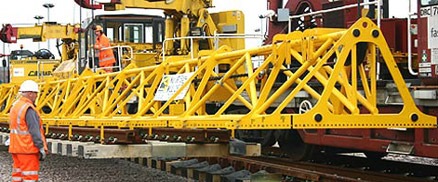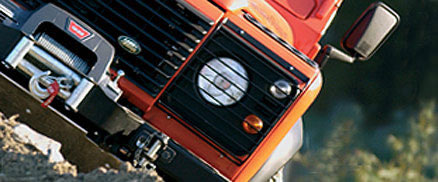February 23rd, 2010
The new jack on the block is the Pow’r Claw Track Jack. This jack has been specifically designed to reduce the risk of injury to the operator, notably back injuries. The Pow’r Jack is an extremely versatile piece of kit and is already setting new standards for safety and productivity amongst track maintenance crews around the world.
The Pow’r Claw came about after heavy use with track maintenance crews in the U.S. and Canada. The Pow’r Claw has a variety of features. The design of the tool is totally inverted which keeps out water and dirt from the jack increasing longevity and performance of the Jack. The pistons are constructed from hard chrome, a resistance to corrosion increasing Jack life.
The biggest feature of the Pow’r Claw Track Jack is operator safety. When this Track Jack was designed it was designed specifically for one man operation – operators whose daily job involved lifting heavy loads such as concrete ties. With a low lever bar force this greatly reduces the risk of injury to the back. The bar is designed not to kick back and injure the operator should it be accidentally released.
Benefits of the Pow’r Claw Jack
- Although light weight weighing only slightly more than a mechanical jack it is extremely heavy duty.
- It can be operated in a horizontal position making it easier for lining or gauging track.
- Offers precise lowering and lifting that is accurate.
- It has a large solid base which provides more surface area and greater support in soft ballast.
- Low handle effort allows one man operation easily for lifting heavy loads such as concrete tie sections.
- Has a safety key lock which prevents the jack toe body from swivelling giving safe and stable support.
- Can be used as jack from either the top or toe.
- Has a removable pump which allows the self contained Jack to be converted to a remote style.
Posted in Arbil Rail |
February 23rd, 2010
When it comes to selecting a winch you can’t just choose the first one that you come across. Winches generate high force and careful consideration needs to be because if the wrong one is chosen it can be dangerous. The paramount concern should be that of safety. Secondly you need to ask yourself a few questions as to why you need a winch – what environment will you be using the winch in and are you a beginner or an expert when it comes to hoisting in the load.
Another important factor when selecting a winch is whether the winch should have the freewheel feature. Freewheels are usually found on ratchet winches. The purpose is to let you pull the cable freely from its drum and then attach it to the load you want to pull in.
It may be this type of winch does not suit your requirements, in which case a self locking winch, brake winch or worm gear winch is probably more appropriate for the task in hand. Any job that requires the lifting of loads a ratchet pulling winch should not be used.
Look at the environment in which you will be using your winch. Environmental conditions such as harsh salt water, causes of potential damage and abuse all need to be considered. How often will the winch undergo maintenance checks? All of these need to be part of the decision making process. For these conditions then a larger winch should be used that has protective guards to prevent damage to the winch.
It is difficult to calculate the exact amount of load that is to be pulled with the winch as different loads have different weights. If using one of the Dutton Lainson hand winches then the total capacity that these types of winches can handle ranges between 35 to 55 pounds. To winch this weight range you should only need to use one hand. If you cannot reel in the load with one hand then the weight bearing is too much for the winch to handle.
Posted in Arbil Lifting Gear |
February 23rd, 2010
Recovery Straps are nylon straps that have the ability to stretch under heavy load and then spring back to almost the original length of the strap. Snatch straps as they are known are constructed like a bungee rope and the combination of the recovery vehicle pull and the tension in the strap creates a ‘snatching’ effect that can pull a stranded vehicle free from being bogged or unable to move under its own power. When used in accordance with these guidelines, vehicles may be recovered with minimal injury risk to people or damage to vehicle equipment.
Always make sure the strap you choose meets the required rating. If the strap has a too light breaking strength then it is prone to breaking under the load. On the other hand a strap with a too heavy breaking strength may not stretch properly causing more damage on the recovery points leading to damage and possible injury.
Before you attempt to recover your stranded vehicle using the snatch strap, make sure you inspect the strap to determine it is in good condition and not damaged. If the strap is wet, dirty or torn it will not perform the job in hand – a strap that is wet will be 20% under full strength where a damaged strap may break.
Roll out the straps between the two vehicles in the shape of an ‘S’. Ensure there are no twists in the strap and make sure there is 2-3 metres slack between both vehicles. If the strap is not long enough do not attempt to join straps, as should the straps break serious injury and damage can occur. Only secure the straps to proper recovery points which are correctly rated on the vehicles.
Important safety recommendations when using snatch straps:
- Before purchasing the snatch strap check the packaging for the stated Minimum Breaking Strength which should be between 2 and 3 times the vehicle’s gross vehicle mass.
- If you intend to use a snatch strap then you should consider completing a recognised four wheel drive training course for advice on the correct usage of a snatch strap.
- Never use a snatch strap for conventional towing or everyday lifting.
Posted in Arbil 4x4 |


